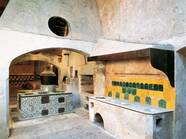Stanley Tucci Captures Giacometti's Final Portrait
Stanley Tucci directs the 2017 film “The Final Portrait.” It is a whitty and encouraging chamber piece based on a true story that covers a brief period of time from when the American writer James Lord sat for a portrait by the world famous artist, Alberto Giacometti while he created the "Portrait of James Lord.” Between the artist’s profane outbursts, chaotic workspace, and countless demands for the young sitter, a connection was established between the two, grounded in a mutual understanding and respect for the process of artistic creation.
Alberto Giacometti is a highly acclaimed contemporary artist from Swizerland, much of his work is displayed around the world and held at the same status as Pablo Picasso and other headlining modern successors. He is known for his rough, eroded, thin sculptural style that focuses on the male and female body. Most of his art exudes realism and nostalgia of the Classical depiction of the human body.
The Cast
In "The Final Portrait," Geoffrey Rush plays Giacometti with great empathy and without a filter, complete with gray wirey hair, glasses, and a lot of cigerettes. Arnie Hammer acts as the young charming writer, James Lord. Despite Giacometti's demands and requests, for whom Lord cancelled many unforgivingly expensive return flights to New York under the impression the portrait would have only taken a few hours, he never once dared to express ingratitude for the opportunity. Sylvie Testud plays Anette, Giacometti’s wife, who seeks vengeance for her husband’s passion for his mistress Caroline, played by the beautiful Clémence Poésy. The final member of the small cast is the multi-talented actor and close friend of Stanley Tucci, Tony Shalhoub, who plays the brother and studio assistant, Luigi Giacometti.
How Tucci Portrayed Characters of Such Complexity
The plotline is developed around the relationship that develops between the artist and his subject. During most of the movie Giacometti creates, destroys, covers up, and scraps nearly completed works right before the sitter’s eyes. A companionship procures from Lord’s assurance that art can be finished, against the painter’s proceedings of outbursts about failure. It seems as though Giacometti needed to create a relationship to project and incorporate Lord's unspoken charactaristics onto the easel, this could be why the portrait lasted 18 agonizing sits. The final portrait stands for a realization that there was nothing more Giacometti could have added or removed, a tangible evidence of overcoming self-doubt.
Lord's Novel: Tucci's Inspiration
Lord’s novel came 20 years before his biography of Giacometti, which superceded the portrait by a year. When Tucci approached Lord with the movie idea over 10 years ago, the American author did not hand over the rights, he was steadfast in the belief that a movie on the portait was an impossible task. When Tucci explained his exact vision, Lord agreed and the long process of “The Final Portrait” began.
Tucci centers his film in Giacometti’s studio primarily, and to the viewer, the experience of the duration of time passed between the two feels extremely realistic. With that, however, the viewer also develops an understanding of the art process, the painstaking hours that are physically and mentally exhausting; experienced both by the artist and the subject. When Giacometti nurtures a liking for Lord, deep memories, hardened truths, and opinions create an uncensored friendship. Lord finally coaxes the frustrated artist into accepting the portrait as a finished piece, after times where the project seemed doomed.
The Portrait, The Novel, The Film
The result of the notorious exchange is a portrait created by Giacometti in 1964 titled the “Portrait of James Lord” and is currently being showed in the National Portrait Gallery in London. The image is created with deep shades of black and charcoal gray. A seated James Lord takes the focal point and the eyes are drawn to the folded hands on his lap. His body language emanates power and strength, his shoulders are thrown back and his chin high while an aura of silvery gray paint surrounds and illuminates him, as if a deity or a Pharaoh.
The film is a snapshot of a mastermind from Lord’s, and then Tucci’s superb composition, and it is not just for art enthusiasts. The film caters to anyone who seeks an encouraging amount of character development. One can pay tribute to Giacometti's ability to break cultural barriers and define contemporary art in his active days. The script is witty, the characters are casted to perfection, and the rendition reminisces an artistic bond that changed history. Tucci admits he was inspired by Lord's novel about his experience sitting with the artist, and has always wanted to direct this film.
Three works of art came from this encounter; the portrait itself, Lord’s 1965 writing account, and in 2017 Stanley Tucci’s dedicational film “The Final Portrait.” A paradigm of the arts transpires; hard work of an artist creating the portrait, Lord’s writing career, and the years of Tucci’s dedication to make the film screen ready, against popular beliefs. All three began with an idea, followed by trials where the vision seemed impossible and needed to be restarted again and again, and a finished product that is perfect in the artist’s eyes. The striking combination of portraiture, writing, and film directing each as a specific field of art come together in this 2017 masterpiece.








































i-Italy
Facebook
Google+
This work may not be reproduced, in whole or in part, without prior written permission.
Questo lavoro non può essere riprodotto, in tutto o in parte, senza permesso scritto.